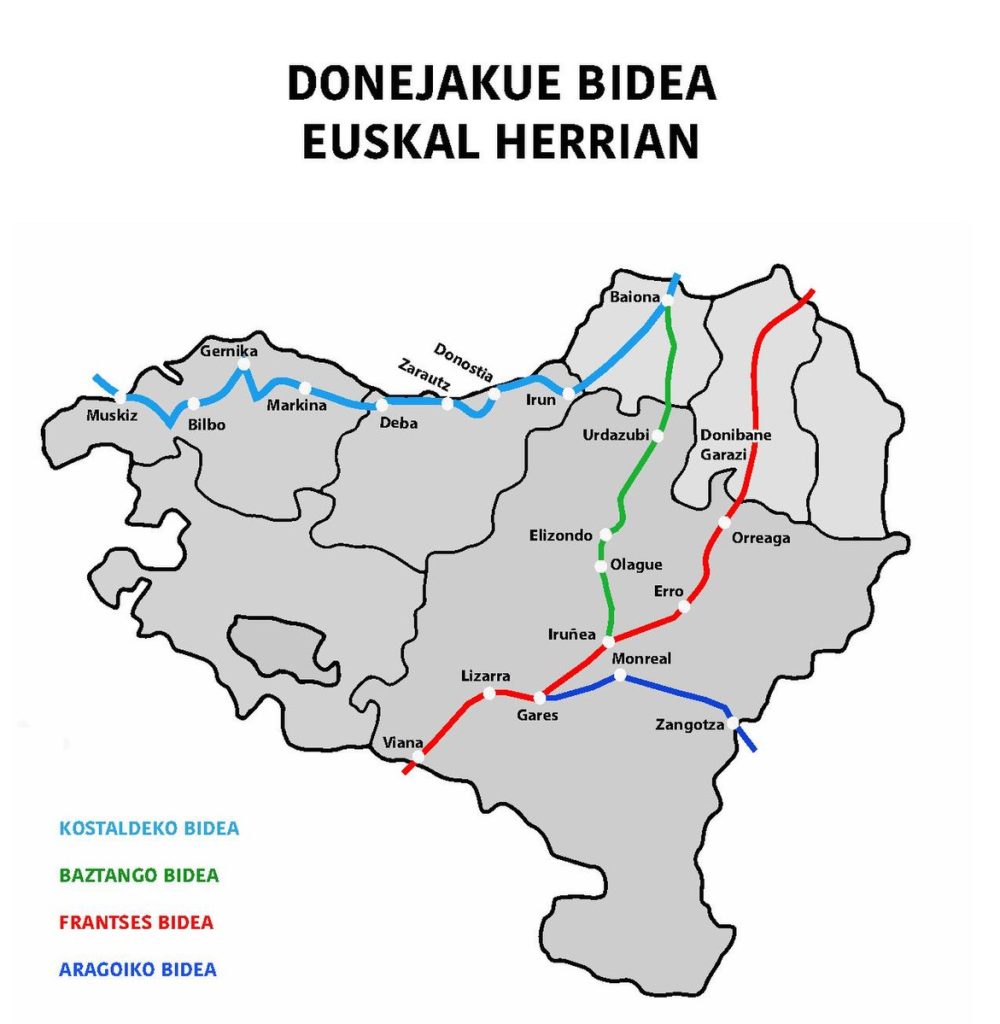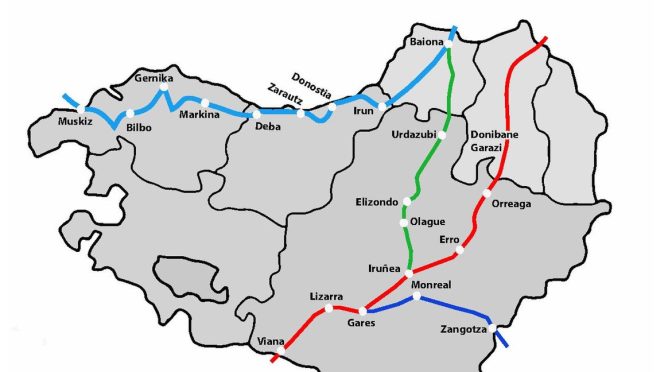The Santiago de Compostela Cathedral, the burial place of Saint James the Great, is one of the most important pilgrimage destinations in all of Christendom – during the Middle Ages, it was one of the three great Christian pilgrimages, along with Rome and Jerusalem. While pilgrims can take many paths to reach Santiago de Compostela, it is hard to avoid passing through the Basque Country. Indeed, two of the most important routes of the Way of St James – the Camino de Santiago, Donejakue Bidea in Euskara – pass through the heart of Euskal Herria.

- There are two primary routes of the Camino de Santiago that pass through the Basque Country. (There are others, but they are smaller in significance.) The more popular route is the French Way. This one starts in Saint-Jean-Pied-de-Port on the French side of the border. It passes through Roncesvalles (Orreaga in Basque, the site of the battle that inspired the Song of Roland) before moving into Nafarroa. It passes through the Nafarroan capital Iruña/Pamplona and the smaller town of Estella, and then on to Logroño in La Rioja. The total length of this route is about 800 kilometers.
- The Northern Way spends more time in the Basque Country. The route became more popular in the Middle Ages as the French Way became compromised by Muslim expansion. This route is also both slightly longer than the French Way (about 817 kilometers) and also more demanding as it follows the coast and has significant changes in elevation along the way.
- The Northern Way, called Iparraldeko bidea in Euskara, starts in the Gipuzkoan town of Irún, near the French-Spanish border. It passes through the capitals of Gipuzkoa and Bizkaia, Donostia and Bilbo, but along the way it visits many other small Basque villages. From Donostia, it follows the coast, passing through the seaside villages of Zarautz, Getaria (home of Elcano), and Zumaia. From Zumaia, it breaks inland a bit before heading back to the coast to reach Deba. From there, the Camino again heads inland into the mountains, going through the towns of Mutriku and Markina-Xemein to the Collegiate of Zenarruza and on to Munitibar as it winds its way to Gernika-Lumo. It then heads to Bilbo, passing through Larrabetzu and Zamudio. Before leaving Bizkaia, the Camino visits Barakaldo and Portugalete as it heads back to the coast and on to Cantabria. Along the route there are many churches and hermitages that were important stopping places for the pilgrims.
- Another important Basque town is Izura-Azme, or Ostabat-Asme. Four different Ways converged on this small town in Nafarroa Beherea.
- The Way of St James was an important economic boost for the region. Drawing large numbers of pilgrims, it provided local businesses with customers. Because of this, some of the towns along the way grew in importance. In 1090, Sancho Ramírez gave special privileges to Estella, and the town reflects the high level of commerce that resulted in, for example, the development of Romanesque architecture. It was also a major vehicle through which ideas were exchanged, as pilgrims from all over Europe met and talked, spreading new ideas further than otherwise possible. The increased traffic also contributed to the rise of the merchant class.
Primary sources: Arozamena Ayala, Ainhoa [et al.]. Camino de Santiago. Auñamendi Encyclopedia. Available at: https://aunamendi.eusko-ikaskuntza.eus/en/camino-de-santiago/ar-27088/; Donejakue bidea Euskal Herrian, Wikipedia; Camino de Santiago, Wikipedia; French Way, Wikipedia; Full Camino del Norte from San Sebastian to Santiago, Caminoways.com
Discover more from Buber's Basque Page
Subscribe to get the latest posts sent to your email.



Very interesting–and valuable–commentary. Dick Etulain
Greetings,
Logrono is a nice town. I did not know that the inquisition extended to Goa and beyond. But it makes sense.
“we seek Christians and spices” was the answer given to a sailor of Vasco da Gama fleet when asked by a native why the Portuguese came to India. Opium was considered a spice.
So they get stoned and kill each other–here we are again presently. The more it changes and more it is the same.
Got to go check on my garden.
Monique